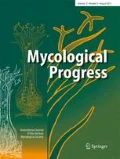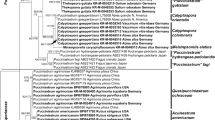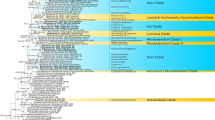Abstract
Systematic relationships between the rusts on Goodeniaceae and Stylidiaceae were examined using phylogenetic analyses with two loci (internal transcribed spacer, large subunit region) from ribosomal DNA. Fresh specimens and herbarium material of four rust species (Puccinia dampierae, P. gilgiana, P. saccardoi and Uromyces scaevolae) from the Goodeniaceae and one (P. stylidii) from the Stylidiaceae were examined. A further species (P. lagenophorae) that is reported from hosts in Goodeniaceae and Asteraceae was included in our analysis. Our phylogenetic analysis recovered the rusts on Goodeniaceae and Stylidiaceae in clades sister to P. lagenophorae on Asteraceae. This supported a taxonomy in which P. lagenophorae is restricted to Asteraceae. Descriptions or taxonomic notes are provided for all of the known rusts on Goodeniaceae and Stylidiaceae.



Similar content being viewed by others
References
Aime MC (2006) Toward resolving family-level relationships in rust fungi (Uredinales). Mycoscience 47(3):112–122. doi:10.1007/s10267-006-0281-0
Beenken L, Zoller S, Berndt R (2012) Rust fungi on Annonaceae II: the genus Dasyspora Berk. & M.A. Curtis. Mycologia 104(3):659–381. doi:10.3852/11-068
Bruckart WL, McClay AS, Hambleton S, Tropiano R, Hill-Rackette G (2007) First Report of Puccinia lagenophorae on Common Groundsel (Senecio vulgaris) in Canada. Plant Dis 91(8):1058–1058. doi:10.1094/pdis-91-8-1058c
Cooke MC (1884) Some exotic fungi. Grevillea 13(65):6–7
Cunningham GH (1924) Second supplement to the Uredinales of New Zealand. Trans Proc N Z Inst 55:393–396
Cunningham GH (1930) Seventh supplement to the Uredinales and Ustilaginales of New Zealand. Trans Proc N Z Inst 61:402–418
Gardes M, Bruns TD (1993) ITS primers with enhanced specificity for basidiomycetes - application to the identification of mycorrhizae and rusts. Mol Ecol 2(2):113–118. doi:10.1111/j.1365-294X.1993.tb00005.x
Katoh K, Asimenos G, Toh H (2009) Multiple Alignment of DNA Sequences with MAFFT. In:Posada D (ed) Bioinformatics for DNA Sequence Analysis, vol 537. Methods in Molecular Biology. Humana Press, pp 39-64. doi:10.1007/978-1-59745-251-9_3
Laundon GF (1967) Terminology in the rust fungi. Trans Br Mycol Soc 50(2):189–194. doi:10.1016/S0007-1536(67)80029-9
Littlefield LJ, Marek SM, Tyrl RJ, Winkelman KS (2005) Morphological and molecular characterisation of Puccinia lagenophorae, now present in central North America. Ann Appl Biol 147(1):35–42. doi:10.1111/j.1744-7348.2005.00010.x
Ludwig F (1889) Ueber einen neuen Goodeniaceenrost aus Sudaustralien. Puccinia saccardoi n. sp. Hedwigia 28:362–363
McAlpine D (1906) The Rusts of Australia: Their structure, nature and classification. Government Printer, Melbourne
Morin L, van der Merwe M, Hartley D, Müller P (2009) Putative natural hybrid between Puccinia lagenophorae and an unknown rust fungus on Senecio madagascariensis in KwaZulu-Natal, South Africa. Mycol Res 113(6–7):725–736. doi:10.1016/j.mycres.2009.02.008
Nylander JAA, Wilgenbusch JC, Warren DL, Swofford DL (2008) AWTY (are we there yet?): a system for graphical exploration of MCMC convergence in Bayesian phylogenetics. Bioinformatics 24(4):581–583. doi:10.1093/bioinformatics/btm388
Petrak F (1953) Ein kleiner Beitrag zur Kenntnis der Uredineen Australiens. Sydowia 7(1–4):1–7
Ronquist F, Huelsenbeck JP (2003) MrBayes 3: bayesian phylogenetic inference under mixed models. Bioinformatics 19(12):1572–1574. doi:10.1093/bioinformatics/btg180
Saccardo PA (1888) Sylloge Fungorum VII
Savile DBO (1971) Coevolution of the Rust Fungi and Their Hosts. Q Rev Biol 46(3):211–218. doi:10.2307/2822510
Savile DBO (1978) Paleoecology and convergent evolution in rust fungi (uredinales). Biosystems 10(1–2):31–36. doi:10.1016/0303-2647(78)90026-6
Scholler M, Lutz M, Wood A, Hagedorn G, Mennicken M (2011) Taxonomy and phylogeny of Puccinia lagenophorae: a study using rDNA sequence data, morphological and host range features. Mycol Prog 10(2):175–187. doi:10.1007/s11557-010-0687-0
Shivas RG (1989) Fungal and bacterial diseases of plants in Western Australia. J R Soc West Aust 72:1–62
Stamatakis A (2006) RAxML-VI-HPC: maximum likelihood-based phylogenetic analyses with thousands of taxa and mixed models. Bioinformatics 22:2688–2690
Stevens PF (2012) Angiosperm Phylogeny Website. Version 12. http://www.mobot.org/MOBOT/research/APweb/. Accessed October 2013
Van Der Merwe MM, Walker J, Ericson L, Burdon JJ (2008) Coevolution with higher taxonomic host groups within the Puccinia/Uromyces rust lineage obscured by host jumps. Mycol Res 112:1387–1408. doi:10.1016/j.mycres.2008.06.027
Vilgalys R, Hester M (1990) Rapid genetic identification and mapping of enzymatically amplified ribosomal DNA from several Cryptococcus species. J Bacteriol 172(8):4238–4246
Weber RWS, Webster J, Engel G (2003) Phylogenetic analysis of Puccinia distincta and P. lagenophorae, two closely related rust fungi causing epidemics on Asteraceae in Europe. Mycol Res 107(1):15–24. doi:10.1017/S0953756202006937
Wilson IM, Walshaw DF, Walker J (1965) The new groundsel rust in Britain and its relationship to certain Australasian rusts. Trans Br Mycol Soc 48(4):501–502. doi:10.1016/S0007-1536(65)80025-0
Acknowledgments
This work was partly funded by the Australian Biological Resources Study, grant number RFL212-33.
Author information
Authors and Affiliations
Corresponding author
Rights and permissions
About this article
Cite this article
McTaggart, A.R., Geering, A.D.W. & Shivas, R.G. The rusts on Goodeniaceae and Stylidiaceae. Mycol Progress 13, 989 (2014). https://doi.org/10.1007/s11557-014-0989-8
Received:
Revised:
Accepted:
Published:
DOI: https://doi.org/10.1007/s11557-014-0989-8




